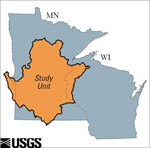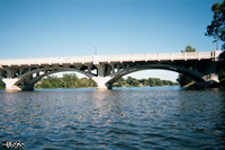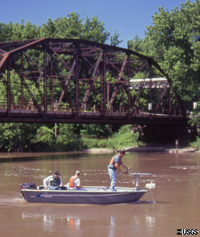Minnesota Water Science Center

UMIS NAWQAUSGS IN YOUR STATEUSGS Water Science Centers are located in each state. 
|
General Information: Geology, Climate, Water Usage, and Land Usage
Average flow of the Mississippi River, 10 miles upstream from Minneapolis, is 7,900 cubic feet per second. The Upper Mississippi River Basin was selected as a NAWQA study area because it contains the headwaters of the most significant river in the Nation, based on area drained, economic importance, intensity of use, and value as a natural resource. The Upper Mississippi River Basin NAWQA study area encompasses more than 48,000 square miles in five states (see FIGURE 1) and includes three major drainage basins--those of the Mississippi, Minnesota, and St. Croix Rivers. 
The average flow of the Minnesota River at Jordan, Minnesota is 3,760 cubic feet per second. Geology, geomorphology, climate, hydrology, and land cover in the study area are diverse and control the occurrence and flow of water, and the distribution of water-quality constituents. Landforms within the study area are primarily the result of Pleistocene glaciation. Soils developed on glacial deposits range from heavy, poorly-drained clayey soils developed on ground moraine to light, well-drained sands on outwash plains. Agriculture is the dominant land use in the southern and western parts of the study area; forests cover much of the northern and eastern parts of the study area, and the Twin Cities Metropolitan Area dominates the east-central part of the study area. 
Average flow of the St. Croix River at St. Croix Falls, Wisconsin (52 miles upstream from its mouth) is 4,300 cubic feet per second. The climate of the study area is subhumid continental. The average monthly temperature ranges from 11 degrees (F) in January to 74 degrees (F) in July. Average precipitation increases from 22 inches in the west to 30 inches in the eastern portion of the study area. About 3/4 of the annual precipitation falls from April-September. The three major tributaries of the Upper Mississippi River Basin are the Mississippi River, the Minnesota River, and the St. Croix River (see FIGURE 1). Runoff in the area varies annually, but mostly occurs in spring and early summer from rainfall on saturated soils. Water quality in the three major tributaries is significantly different. Among the three rivers, concentrations of total-suspended solids and total-suspended sediment are greatest in the Minnesota River and least in the St. Croix River.
The estimated population of the study area is approximately 3 million people, 2.4 million of whom live in the Twin Cities Metropolitan Area. In
1990, public water supplies served about 2.1 million people in the study area. An average of 360 million gallons of water per day were used; 53 percent was from ground-water sources and 47 percent was from surface-water sources. Suburban
and rural areas primarily used ground water as a source of municipal-water supplies. Surface water is predominantly used by the cities of Minneapolis, St. Paul, and St. Cloud and for thermoelectric purposes.

About 60 percent of the study area is used for agriculture (see FIGURE 2). Principal crops grown in the study area include corn, soybeans, and hay. About 23 percent of the study area is occupied by forests, and the remaining 17 percent of the study area is covered by water (5%), wetlands (7%), urban and suburban areas (5%). The study area is underlain by glacial sediments and by a thick sequence of limestone, shale, shaley sandstone, and sandstone of Precambrian and Paleozoic age. Glacial deposits in the western part of the study area are composed of ground moraine and outwash deposits, and the land surface is relatively flat; the eastern part of the study area contains numerous end moraines and has substantial local relief. Glacial meltwater left numerous flat plains of outwash sand throughout the study area. Hydrogeologic units in the glacial deposits include surficial and buried aquifers and confining units. The Anoka Sand Plain aquifer (see FIGURE 3) is a major surficial aquifer that extends for 1,700 square miles in the study area. Wells completed in that aquifer can yield more than 500 gallons of water per minute. Many other stratified-drift aquifers cover small areas and have little hydraulic connection with other aquifers. Bedrock aquifers and confining beds are part of a thick sequence of sedimentary rocks that were deposited in a north-south trending trough referred to as the Hollandale Embayment (see FIGURE 4). Up to 1,200 feet of those rocks underlie the Twin Cities. The bedrock hydrogeologic system of the study area can be divided into four major aquifers separated by confining units. The aquifers are, in descending order, the St. Peter, the Prairie du Chien-Jordan, the Ironton-Galesville, and the Mt. Simon-Hinckley. The confining units are the Platteville and Glenwood, the basal portion of the St. Peter Sandstone, the St. Lawrence-Franconia, and the Eau Claire. Crystalline rock and minor aquifers and confining units underlie these major aquifers. |